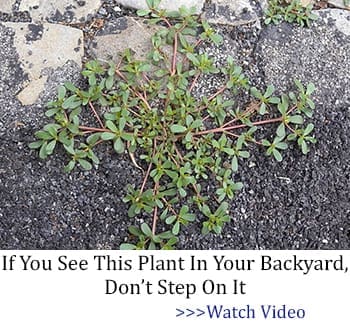I often see people post pictures of this plant on social media, asking what this plant is, and it drives me nuts!
Wisteria is pretty, yes! But not fun to deal with.
It’s almost impossible to fight with, especially if a lot of it exists near your property, where you can’t control it.
I have one neighbor who doesn’t seem to care about the invasiveness of this plant, as she let it take over her oak tree. This aggressive vine occasionally shoots out seedpods in all directions, which take about a week grow.
Even if you poison or cut the mother vine, it’ll reload, shoot pods, and grow in the smallest of cracks.
In this article, I’ll discuss why you should never plant Wisteria near your house, as well as give you quick tips for keeping it under control.
General Aspects
Scientific Name: Wisteria Sinensis/Floribunda. We know it being Japanese or Chinese Wisteria
Wisteria is a big risk, big reward type of plant. With its early summer cascades of mauve and lilac blooms, it is a vision of sheer elegance.
The romantic blooms and twisted vines of these vigorous growers will be yours to appreciate for years if you have the time and effort to diligently care for them. However, some naive growers often find themselves trapped in a horror story of unchecked Wisteria gone berserk.
Because it grows so quickly and becomes so massive, it kills trees and shrubs by snaking its way through and around them, blocking off sunlight from reaching the forest understory. Additionally, it can smother foliage and strangle branches, hence weakening the plant and increasing its vulnerability to storm damage.

Why You Should Never Plant Wisteria Near Your House
Here are some reasons not to grow Wisteria near your property:
Related: If You See These Bugs In Your Garden, Get Rid Of Them Immediately!
-
Wisteria Vines May Damage Property Structures
The majority of terrifying Wisteria tales you’ll hear are about structural damage. The vines can destroy a wall or fence, bring down a trellis, and cause serious harm to your house.
Wisteria has a history of growing into gaps near doorways and windows, buckling the frames, or shattering glass in the process. The vines can ascend into gutters or wrap around downspouts. The exterior of your house can be penetrated by this aggressive vine in a variety of ways.
Another issue is the sheer weight and size of a mature vine, which needs a very powerful support structure to keep it upright. After several years of contentedly climbing and growing, the vine finally takes over the structure to the point where it is difficult to see it anymore.
Once the Wisteria grows large and heavy enough, owners will realize that the entire building (a small shed for example) could collapse under the massive weight of the vine.
Because of this, I don’t advise planting it close to your home, garage, shed, neighbor’s home, walls, or anything else you don’t want it to climb onto.

-
Wisteria Roots May Damage Your Drainage System
In some instances, planting Wisteria in the wrong location can result in damage caused by the vine’s roots.
There is always a chance that the root system of your Wisteria plant could harm your septic tank, irrigation system piping, or other underground pipelines, drains, or structures.
Wisteria roots, however, aren’t as harmful as some other plants whose roots actively grow outward. Nevertheless, when planning, bear in mind that we advise keeping Wisteria six or more feet away from your house or any other significant structures.

-
Wisteria Vines May Harm Trees and Other Plants
Wisteria can cause harm to other plants and trees if it’s allowed to spread invasively through the ecosystem. The vine spreads quickly and will outcompete neighboring plants for resources like sunlight and water.
Although it might be alluring, it’s not a good idea to let the vine climb up a big tree’s trunk. Wisteria can harm any tree, no matter how big it is.
It won’t just climb directly up the side of the tree, it will gradually encircle the trunk until it reaches the top. Additionally, it will disperse and tangle itself around branches and limbs, strangling and stunting the development.
Wisteria will continue growing for many years. If the vine is never cut or pruned, it can survive for fifty years or more. That means the nearby plant life will be under siege for a very long time.

-
The Seeds are Toxic
One of the more terrifying drawbacks of growing Chinese/Japanese Wisteria is its toxicity.
Although the seedpods it creates are fuzzy and ornamental, the seeds inside are deadly. Children and animals are most at risk. If ingested, a trip to the vet or emergency room will be necessary.
How to Control an Out-of-Control Wisteria
The majority of people who deal with an out-of-control Wisteria either planted it years ago and neglected it, or they inherited one when they moved into their new home. In either way, you can prune your vine back into control. But it’s not an easy job.
If your Wisteria plant is already out of control, you’ll need to take drastic measures and give the vine severe pruning. You might need to use a ladder to get to the top of the growth, depending on how big it is.
Pull the Wisteria down and trim the branches to the root if it is encroaching areas you don’t want it to, such as the side of a tree, a weak fence, or up the side of your house. Remove any dead branches and cut down any excessively long shoots. Cut any suckers that are growing around the base of the Wisteria.
The best time to prune aggressively is in the winter when the plant is dormant and has no leaves. The vine’s shape will be easier to identify, and you’ll know which ones to cut off. In rare circumstances, you might even need to seek the assistance of a professional landscaper.
Related: These Invasive Herbs Will Devastate Your Backyard

How to Remove Japanese/Chinese Wisteria
In some instances, you could decide it’s best to get rid of your Wisteria entirely. Although these vines are beautiful, some gardeners may find them to be too much to handle. Fortunately, there are various ways to take to get rid of unwanted Wisteria from your yard.
If you want to completely purge your yard of Wisteria, you must destroy or remove all of the branches, seeds, foliage, and the vine’s roots.
Just be aware that Wisteria is a persistent grower who won’t give up easily. Hence, to prevail in this conflict, you must be diligent and persistent. You might choose to dig up the plant if there is only one and it isn’t too big. Even though it takes a lot of work, this method is quick and doesn’t involve the use of chemicals or poisons.
This can be your best option if the Wisteria is close to other plants you want to retain. You should prune the stems until just a little stump or trunk is left before removing the roots.

After you’ve cut it down, dig around the vine with a pointed shovel or spade, starting about two feet from the trunk and going all the way down to the roots. To free the root ball, you might need to cut through a few of the roots. As you move around the trunk, insert the shovel and pry underneath the root ball with it. You should eventually succeed in getting it loose enough to lift the root ball off the ground.
Go deeper and pull out any further roots you uncover to prevent them from sprouting new branches. Following the removal of the primary plant, you will need to keep an eye out for any new growth and work rapidly to kill or remove it. It can take several seasons of doing this to get rid of the Wisteria.
Wisteria Alternative
You could consider growing the less invasive American Wisteria (Wisteria frutescens) as an alternative. This gorgeous vine, which is native to eastern North America, is just as magnificent despite having slightly smaller blooms. It’s significantly less invasive, and much less likely to spiral out of control than its Asian counterparts.
The blossoms are a sure way to recognize American Wisteria. The flowers of the vine are shorter, rounder, and more compact than those of Asian species, which have elongated blossoms with loose, dripping petals.
You may also like:
 Gardening Mistakes That Might Get You Killed
Gardening Mistakes That Might Get You Killed
If You See This Plant in Your Backyard, Burn It Immediately! (Video)
Cheap Ways To Get Rid Of Invasive Ants
How To Get Rid Of Tomato Hornworms Before They Destroy Your Tomato Plants








